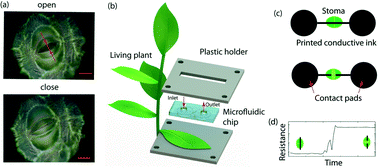Our official English website, www.x-mol.net, welcomes your
feedback! (Note: you will need to create a separate account there.)
Persistent drought monitoring using a microfluidic-printed electro-mechanical sensor of stomata in planta
Lab on a Chip ( IF 6.1 ) Pub Date : 2017-11-08 00:00:00 , DOI: 10.1039/c7lc00930e Volodymyr B. Koman 1, 2, 3, 4 , Tedrick T. S. Lew 1, 2, 3, 4 , Min Hao Wong 1, 2, 3, 4 , Seon-Yeong Kwak 1, 2, 3, 4 , Juan P. Giraldo 4, 5, 6 , Michael S. Strano 1, 2, 3, 4
Lab on a Chip ( IF 6.1 ) Pub Date : 2017-11-08 00:00:00 , DOI: 10.1039/c7lc00930e Volodymyr B. Koman 1, 2, 3, 4 , Tedrick T. S. Lew 1, 2, 3, 4 , Min Hao Wong 1, 2, 3, 4 , Seon-Yeong Kwak 1, 2, 3, 4 , Juan P. Giraldo 4, 5, 6 , Michael S. Strano 1, 2, 3, 4
Affiliation

|
Stomatal function can be used effectively to monitor plant hydraulics, photosensitivity, and gas exchange. Current approaches to measure single stomatal aperture, such as mold casting or fluorometric techniques, do not allow real time or persistent monitoring of the stomatal function over timescales relevant for long term plant physiological processes, including vegetative growth and abiotic stress. Herein, we utilize a nanoparticle-based conducting ink that preserves stomatal function to print a highly stable, electrical conductometric sensor actuated by the stomata pore itself, repeatedly and reversibly for over 1 week. This stomatal electro-mechanical pore size sensor (SEMPSS) allows for real-time tracking of the latency of single stomatal opening and closing times in planta, which we show vary from 7.0 ± 0.5 to 25.0 ± 0.5 min for the former and from 53.0 ± 0.5 to 45.0 ± 0.5 min for the latter in Spathiphyllum wallisii. These values are shown to correlate with the soil water potential and the onset of the wilting response, in quantitative agreement with a dynamic mathematical model of stomatal function. A single stoma of Spathiphyllum wallisii is shown to distinguish between incident light intensities (up to 12 mW cm−2) with temporal latency slow as 7.0 ± 0.5 min. Over a seven day period, the latency in opening and closing times are stable throughout the plant diurnal cycle and increase gradually with the onset of drought. The monitoring of stomatal function over long term timescales at single stoma level will improve our understanding of plant physiological responses to environmental factors.
中文翻译:

使用微流体印刷机电传感器监测植物中的持续干旱
气孔功能可以有效地用于监测工厂的水力学,光敏性和气体交换。当前的测量单个气孔孔径的方法,例如铸模或荧光技术,不允许在与长期植物生理过程(包括营养生长和非生物胁迫)相关的时间范围内实时或持续监测气孔功能。在本文中,我们利用保留气孔功能的基于纳米颗粒的导电油墨,反复且可逆地打印超过1周的,由气孔本身驱动的高度稳定的电导率传感器。此气孔机电孔径传感器(SEMPSS)允许用于封闭倍单个气孔开口的等待时间的实时跟踪和在植物中我们的结果表明,前者的变异范围为7.0±0.5至25.0±0.5分钟,后者的变异程度为53.0±0.5至45.0±0.5分钟。这些值显示出与土壤水势和萎反应的发生相关,并与气孔功能的动态数学模型定量吻合。显示了Spathiphyllum wallisii的单个气孔可区分入射光强度(高达12 mW cm -2)),时间延迟慢至7.0±0.5分钟。在七天的时间内,打开和关闭时间的潜伏期在整个植物的昼夜周期中是稳定的,并随着干旱的发生而逐渐增加。在单个气孔水平上长期监测气孔功能将增进我们对植物对环境因素的生理反应的了解。
更新日期:2017-11-08
中文翻译:

使用微流体印刷机电传感器监测植物中的持续干旱
气孔功能可以有效地用于监测工厂的水力学,光敏性和气体交换。当前的测量单个气孔孔径的方法,例如铸模或荧光技术,不允许在与长期植物生理过程(包括营养生长和非生物胁迫)相关的时间范围内实时或持续监测气孔功能。在本文中,我们利用保留气孔功能的基于纳米颗粒的导电油墨,反复且可逆地打印超过1周的,由气孔本身驱动的高度稳定的电导率传感器。此气孔机电孔径传感器(SEMPSS)允许用于封闭倍单个气孔开口的等待时间的实时跟踪和在植物中我们的结果表明,前者的变异范围为7.0±0.5至25.0±0.5分钟,后者的变异程度为53.0±0.5至45.0±0.5分钟。这些值显示出与土壤水势和萎反应的发生相关,并与气孔功能的动态数学模型定量吻合。显示了Spathiphyllum wallisii的单个气孔可区分入射光强度(高达12 mW cm -2)),时间延迟慢至7.0±0.5分钟。在七天的时间内,打开和关闭时间的潜伏期在整个植物的昼夜周期中是稳定的,并随着干旱的发生而逐渐增加。在单个气孔水平上长期监测气孔功能将增进我们对植物对环境因素的生理反应的了解。











































 京公网安备 11010802027423号
京公网安备 11010802027423号